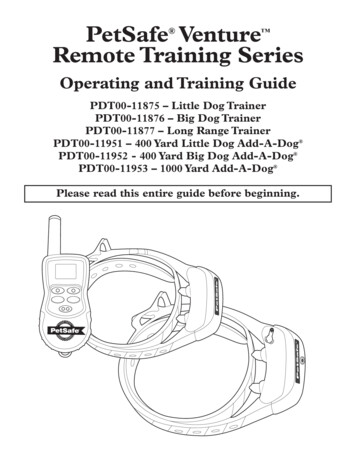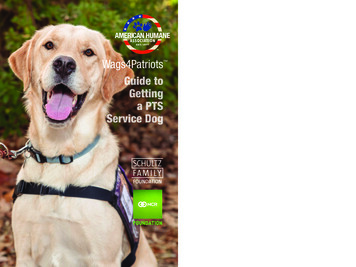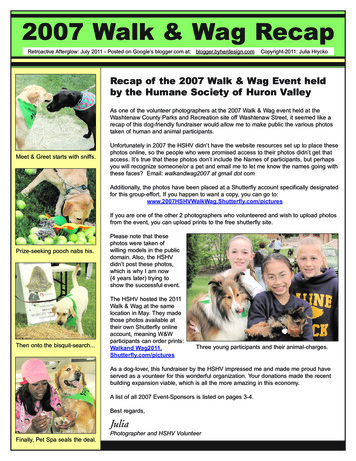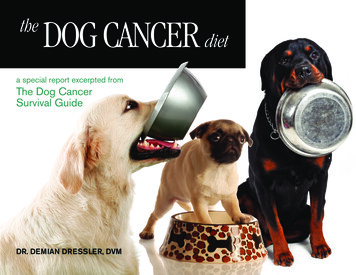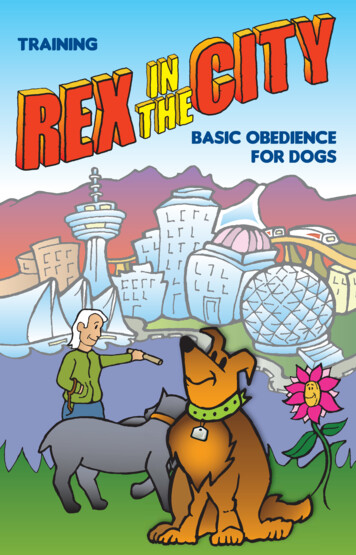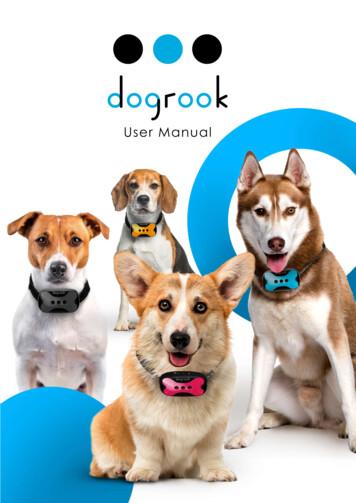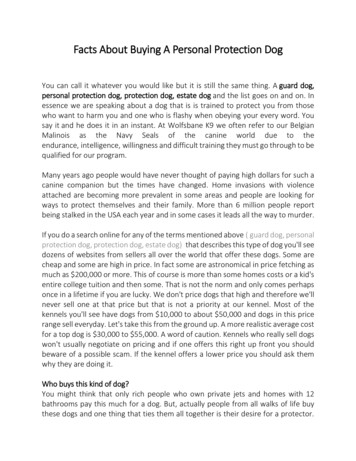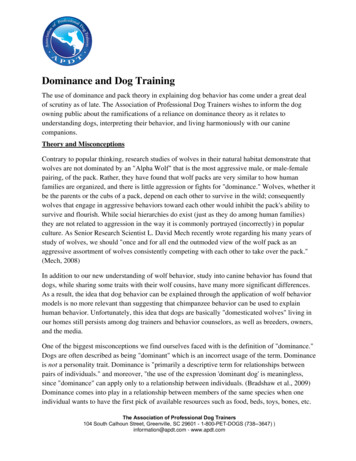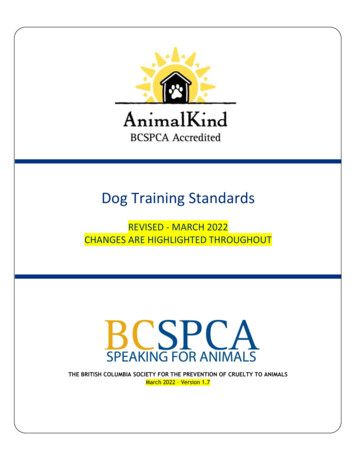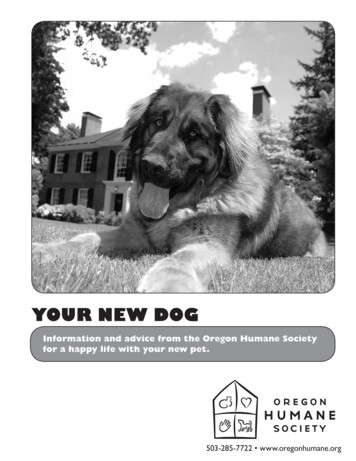
Transcription
Your New DogInformation and advice from the Oregon Humane Societyfor a happy life with your new pet.Oregon Humane Society Dog Adoption Booklet 1503-285-7722www.oregonhumane.org
2Oregon Humane Society Dog Adoption Booklet
CONGRATULATIONS!Thank you for adopting a companion animal from the Oregon Humane Society!This booklet is designed to address many of the questions you may have about how to carefor your new dog. Please give us a call if you need any additional information or advice.Oregon Humane Society 503-285-7722We also suggest that you take advantage of our pet advice section on our website atwww.oregonhumane.org and look for our educational classes held here at theshelter. Workshops and individual private training sessions are also available. Look on ourwebsite under “Pet Training” for more information.Oregon Humane Society Dog Adoption Booklet3
TABLE OF CONTENTS1 Settling In Protocol–Quick Guide52 Preparing Your Home63 The Ride Home777On Arrival HomeYour New Dog’s Health4 Introducing Your New Dog To Other PetsDog to DogDog to CatDog to Caged PetChildren & Dogs499910105 Developing Routine and Structure With Your New Dog116 Behavior & TrainingPuppiesPuppy KindergartenHouse TrainingCrate TrainingChewingJumpingBarkingBoltingHome-Alone AnxietyThe Outdoor DogTraining at Home1212131314151616161617177 Medical Treatment188 Conclusion20Oregon Humane Society Dog Adoption Booklet
CHAPTER 1Settling in Protocol–Quick GuidePlease follow these suggestions:DO’S Show your new dog what to do. Show him where to go potty; show him where his food, water, and bed are;and praise him for everything he does that you like. Reward good behavior with praise and small (the size of your pinky nail) food treats. If your dog knows “sit” have him “sit” for everything (feeding times, doors opening, leash, etc.) If he doesn’t,just wait for a calm moment when he is standing nicely and not jumping up, etc., and reward the calm behavior. Use a regular “flat” collar and keep his leash on, even in the house at first, to aid in moving him off the couchor out of the kitchen or off guests, etc. When he eats dinner, have him wait or sit first. Once he’s begun eating, move away from the dish and donot disturb him. Supervise, supervise, supervise every interaction with kids and current pets. If the dog is crate trained, please use the crate for calm confinement. Have him sleep in the crate at night inyour bedroom. Ask us for our advice if he is not crate trained. Go for long, on-leash walks for the purpose of brisk exercise. Start a training class with your new dog.Don’ts Avoid all use of punishment! It is best to ignore and properly manage undesirable behaviors and rewardthe desirable ones. Don’t give your dog long-lasting high-value food items (bones, rawhides, etc.), as they can causepossession issues. Don’t wrestle or play tug-of-war with your dog. Don’t allow too much freedom. Keep him on a leash at first (even inside your home, especially withkids or cats present). Don’t bathe or groom your new dog right away, and especially do not try to trim his nails. Don’t overwhelm him by having a party, inviting relatives/kids over, etc. Don’t take him to the dog park (even if he is good with other dogs). Don’t physically force your dog to do anything. Use your leash and treats to lead or lure him whereyou need him to go. Do not let kids crowd the dog, take him for a walk, hug or pick up the dog and do not allow anyunsupervised interactions. Don’t overwhelm your new dog by going to crowded places such as markets, parks, schools, etc.Find quiet and calm places to begin with.Oregon Humane Society Dog Adoption Booklet5
CHAPTER 2Preparing Your Home· Prepare a safe room where the dog/puppy canbe left alone.· Buy or rent a crate or puppy exercise pen.· Remove breakable objects; ensure electrical wiringis safely covered or out of dog’s reach.· Put away shoes, belongings, papers, kids’ toys, etc.· Remove trash cans, or secure inside cabinets and putaway food left on the counter. Move cat food and litter box out of dog’s reach.· Is your fence/gate secure? Is the ground free ofsharp objects, poisonous plants?Buy the following supplies (all of which can bepurchased at the Oregon Humane Society’s BestFriends Corner retail center):-Food: The Oregon Humane Society encouragesfeeding a high-quality dry kibble suited to yourdog’s age and size. Talk with your veterinarianabout dietary requirements.-Dishes: Ceramic or stainless steel are preferredbecause they don’t harbor bacteria like plasticdoes and are less likely to become chew toys.-Bed: Your dog needs a soft, dry, clean placeto lie down.-Toys: To exercise your dog physicallyand mentally, choose from a wide variety ofpuzzle and game toys.-Grooming supplies: Choose appropriate toolsfor your dog’s coat.-Collar/leash: A flat collar that the dog canwear safely at all times, to which you can attach hisidentification tags and a 4’or 6’leash. A bodyharness is often more suitable for small dogs.-Enzyme-based cleaner: These cleaners helpwith potty accidents by removing all residualodors from accident sites.6Oregon Humane Society Dog Adoption Booklet
CHAPTER 3The Ride HomeWe recommend your new dog ride homein a crate or secured in your car’s backseat. Never put a dog in the back of anopen pick-up truck.· If you have your current dog with you, keep thedogs separated on the journey home from the shelter,as your existing dog may feel the car is his space thatneeds protecting. Leave the leash attached to the dog’s flat collar(you can fasten it through the seat belt).· Do not allow children to excite the dog. Do not give the dog a long-lasting food treat orrawhide in the car.· Take the dog directly home. Don’t stop on the wayhome for supplies or to visit friends.· If the dog vomits, simply clean it up withoutpunishing the dog.· Do not leave the dog alone in your car.· Before you open the car door, get hold of the leashso the dog cannot bolt.On Arrival Home· Take your dog on the leash to the area that you wanther to go potty. Do not play with her until sherelieves herself. Praise her for using this area andgive her a treat.· Take your dog inside, show her where her food andwater is. Keep her leash on for control.· Act very low key and don’t excite her with play.· As she is exploring her new home, watch hercarefully. If she attempts to urinate inside, quicklyescort her to her area in the yard. When she uses thisarea correctly, praise her.· Keep the doors closed to any areas where she isnot allowed.· A calm and consistent first few days will help yourdog settle in with minimal stress.Initially don’t leave your new dog with the run of thehouse. As he becomes more mature and learns to bebetter behaved, you can give him more freedom. Trynot to blame your dog for being a dog, blame yourselffor not putting things away.Your New Dog’s HealthDogs and puppies need time to adjust totheir new homes and surroundings. Thestress of the change in environment canweaken a dog’s immune system and makehim more susceptible to illness. In the firstfew weeks following the adoption, monitoryou pet closely for the following:Kennel CoughKennel cough, or canine infectious tracheobronchitis,is one of the most prevalent infectious diseases in dogs.All OHS dogs are vaccinated against kennel coughbefore being placed in the adoption kennels. However,sometimes dogs OHS receives as transfers from othershelters may already have been exposed to the virus,or a dog may be exposed within the window of timebefore the vaccine has become protective. Potentialadopters who bring in their own dogs for a pet meetat the shelter should be aware that their pet is beingexposed to kennel cough.The following can all be signs of kennel cough:· A dry, hacking cough (often sounds as if somethingis ‘caught in the throat’)· Retching or gagging (often producing clear,foamy saliva)· Nasal discharge· Sneezing· LethargyOregon Humane Society Dog Adoption Booklet7
Most dogs with kennel cough do not have a feverand, apart from the cough, can appear healthy andenergetic. If your dog has a fever, is less active thanusual, has a decreased appetite, has discharge from theeyes or nose or has difficulty breathing, please consultyour veterinarian immediately, as a more seriousproblem may be present.Important! Please remember that kennel cough iscommon and contagious but is very rarely fatal. Wealways recommend that all newly adopted dogs beseen by a vet of the adopter’s choice within a week ofleaving the shelter.ParvovirusAt OHS all incoming puppies are vaccinated for themost common canine diseases immediately uponarrival. One virus that primarily targets puppies lessthan 6 months of age is the canine parvovirus.8Oregon Humane Society Dog Adoption BookletParvovirus infection causes vomiting and diarrheawhich is often bloody. Puppies are lethargic andreluctant to eat. This disease progresses quickly andcan be fatal. If you notice the above symptoms in yournewly adopted puppy, please contact your veterinarianimmediately. If your puppy is diagnosed with parvo byyour veterinarian, please call the OHS medical staff at503-285-7722 ext. 414.Until your puppy receives a full series of the DA2PPvaccine following the schedule your veterinarianrecommends, it is important to limit his exposure toareas where other dogs frequent, such as dog parks, petstores, and public green spaces.
CHAPTER 4INTRODUCING YOUR NEWDog TO OTHER PETSDog To DogYou are off to a good start as the dogs met alreadyat our shelter, but before you go inside, take a shortwalk with your dogs (NOT TO THE DOG PARKTHOUGH!) to help reduce stress. Arguments oftenoccur when entering territory, going through doorsor gates, in tight spaces, around food, toys, beds,games and over your attention. Fights can be avoidedby giving the dogs time and space to get to knoweach other calmly. Keep the leash on the new dogand control his movements. Do not give either dogattention until both are quiet and well behaved. It canhelp to increase praise to your current dog wheneverthe new dog approaches.Dog To CatBe prepared before the dog comes home. Make surethe dog does not have access to the cat’s food and waterand especially the litter box! When introducing yournew dog to your cat, put the cat on a raised surfacelike a table or dresser. This will help the cat feel lessthreatened. Bring your new dog into the house on aleash. If they both seem calm, allow them to sniff eachother and then distract the dog with a treat or praise.After a few meetings, if all has gone well, you can dropthe end of the leash and let him drag the leash aroundthe house so you can grab it if necessary. It is normalfor the cat to hiss and growl at first, especially if she hasnot lived with a dog before. Cats take time to adjust tochanges. Never allow the dog to chase the cat, even inplay, as this situation can easily get out of control.Important! Do not feed the dogs next to eachother. Refrain from giving either dog a bone or longlasting food treat, as this can easily lead to fighting.Wait until they are accustomed to each other (a fewweeks). Remember that food guarding is a normal dogbehavior and there are some dogs that may never beable to eat together.If you are worried at any point, pick up the leash andwalk the new dog away. It may help to spray the dogswith water if they start to fight. Do not grab either dog,as you may get bitten by mistake.Avoid playing high arousal games with the dogs. Tugof-war or a fast game of fetch may cause a fight to breakout as they are both energized. Do not expect the dogsto share the same bed. It may be wise to crate your newdog until a relationship is established and you knowshe is potty trained. Eventually it would be ideal tohave both dogs, with a dog bed each, sleeping in thesame room (your bedroom, as they love to be nearyou). Separate the dogs when you are not home untilthey have proven that they can get along.If the initial interaction isn’t good then keep a distancebetween them to allow time for adjustment. Distract thedog with treats and reward calm behavior. You can tryspraying them with water if they start to fight, or throwa towel over the cat if he attacks the dog. Make surethe cat has an escape route or can leap to a high place.Do not let the dog chase or corner the cat or vice versa.Separate them when you are not there to supervise untilyou all are comfortable with the situation.If your cat hides, don’t worry. Make sure the cat has aprivate place not accessible to the dog where she caneat and drink in peace and feel safe. Insure that the cathas access to her litter box, but that the dog does not.Allow the pets to adjust in their own time - be patientand act calm and relaxed. Often they become friends,but sometimes they just tolerate each other. Either wayyou should respect the arrangement.Oregon Humane Society Dog Adoption Booklet9
Introduction–Dog To Caged PetGenerally, keep caged pets out of the reach of yourdog in secure habitats in a separate room. Anyintroductions should be done with the dog on leashand must be monitored carefully. Most small pets getvery nervous and frightened because many dogs havea prey drive towards these types of animals. Always bepresent and keep visits short.Children & DogsIt is very important to consider carefully whether a newdog is a good choice when you have young children.Many puppies and dogs think of children as littermatesbecause children have higher pitched voices, get easilyexcited, run and fling their arms about, and are closerto the dog’s size. All of these behaviors signify “PlayTime” for a dog or puppy and they become excited andoveractive. The puppy/dog interacts in play with thechildren, just as it would with other dogs/puppies. Theynip, jump up, bang into, knock over and wrestle with theclothes of children. Also, young children are not capableof handling dogs with proper gentleness. They want tohug and squeeze the dog and are often too rough despitetheir sweet intentions.*** SUPERVISE ALL INTERACTIONS WITHCHILDREN AND ANIMALS***If the dog is getting too excited, teach the children tostand still “like a tree;” fold arms and hide hands, thenwalk away slowly and calmly. Teach your children howto interact with dogs:· Allow the dog to approach you, not the otherway around!· Pet the dog under the chin or chest.· Don’t look directly into the dog’s eyes.· NEVER approach or touch a strange dog. Never disturb a dog who is eating, chewingor sleeping. Do not allow children to climb on the dog,hug tightly, pull the tail, or grab feet. Keep your children’s faces away from the dogs.10Oregon Humane Society Dog Adoption BookletLook for these warning signs that a dog is anxious:· The dog is standing stiffly.· He is looking sideways at the child. He is trying to get away or hide. His tail is tucked.· He emits a low, deep growl.· He is staring your child in the eye, with a raised lip.Most Importantly:· Never run from a dog; his natural instinct willbe to chase.· If a dog does run up to you, freeze with your armsfolded or by your sides. Once the dog loses interest,walk away slowly.RESPECT YOUR DOG–and encourage others to dothe same.Your new pet is your friend and companion. Forciblymoving him, hitting or pinning him down will leadto problems. The dog may see you as a threat, assomeone to fear, and may shut off from you or becomeaggressive. Your pet should welcome your touch andnot be afraid of you.
CHAPTER 5Developing Routineand Structure WithYour New DogThe whole family should use the samepositive training methods for your newpet. Your new dog will be looking to youfor clear guidance and gentle leadershipto shape his good behavior. Be consistentand patient.· Provide clear rules and guidelines. There is nevera need to physically reprimand your pet. Time outs,ending the game and removing rewards are suitablepunishment for a dog that is learning where theboundaries are. Make sure the boundary line doesn’tkeep moving or your dog will become very confused.Please take a training class.· Go slowly. Introduce new surroundings androutines gradually.· Feed on a regular schedule and teach your dog to sitand stay before giving him his dinner. Don’t disturbhim while eating.· Sleeping–Don’t let your new dog sleep on your bed(he can do this at a later date as long as he will getoff cheerfully on your cue). Other great sleepingoptions are having a doggy bed placed next to yourbed or in a crate. Catch your dog doing something right (lying on hisbed, chewing his OWN toys, sitting for attention,etc.) and reward with affection, attention and treatswhen he is polite or does what you ask.· Initially give your dog a confined amount of space inthe home—not free run of the entire house. Restrictaccess until you establish some training and get toknow your new pet better.· A tired dog is a good dog! Your dog will not exercisehimself, so leaving him in your yard all day just won’twork. Dogs need to use their brains as well as theirmuscles, so if you don’t have time to regularly playwith and walk your dog, you should reconsiderwhether you have time for a dog at all.As with people, dogs develop new behaviors andchange with age. You should be prepared to continueyour dog’s training and guidance throughout his life.Teach and train with patience and rewards. The resultswill be amazing!Oregon Humane Society Dog Adoption Booklet11
CHAPTER 6Behavior & TrainingUnderstanding your dog’s behavior andlearning how dogs think will make life withyour new pet happier and easier. Positivereinforcement, also known as reward-basedtraining, is proven to be far more effectivein creating a well-adjusted, well-mannereddog than punishment-focused methods.OHS recommends all new dogs/puppies and theirfamily members attend at least a basic training courseto solidify the loving bond and to help him understandwhat is expected of him.PuppiesThe experiences your puppy has, or doesn’t have, willshape him for the rest of his life. Introduce your puppyto new experiences gradually and make sure theseexperiences are positive and not overwhelming.Puppies may whine a lot their first few days in theirnew home. Remain calm; this phase will pass as yourpuppy gains confidence and feels secure.Begin teaching your puppy basic manners as soonas you get him home. Take advantage of your dailyroutine; when feeding, ask the puppy to come, sit andstay until you give the okay to eat. Ask him to sit orwait before letting him out of his crate, going throughdoors, etc.Teach your puppy to be very gentle with his teethon human skin and to chew on appropriate toys andbones. If your puppy hurts you with his teeth, simplysay “ouch” and ignore him for a minute. Please donot use physical punishment. Dogs work on instinctsthat you cannot change but you can redirect. Hittingor tapping on the nose, etc., only reinforces that youcause pain.Photo by Four-Legged Photo12Oregon Humane Society Dog Adoption Booklet
Practice touching your puppy on his paws, tail, ears,etc., and reward relaxed behavior with treats and kind,calm praise. Regularly groom your puppy and wipe hisfeet off (even if it isn’t raining).Do not play wrestling games or tug-of-war. A nicegame of fetch is better.Puppy KindergartenPuppy kindergarten is a series of classes for puppiesaged around 8-16 weeks. During these valuable weekswhen your puppy is very open to learning, you will betaught how your puppy thinks and feels, and the bestway to influence his/her behavior for the future.Your puppy also will be exposed to lots of positiveexperiences in a controlled and safe environment.Learning to interact with other puppies and dogs andwith other people and children is very beneficial at thisearly age. Please look on our web site for a current listof puppy classes and information.House TrainingPuppiesA good rule of thumb is puppies can control theirbladders for approximately one hour of time for eachmonth of their age. In other words, a three-month-oldpuppy cannot be expected to last more than threehours without relieving himself and typically theyneed to defecate 10-20 minutes after eating.Consistency and routine are key. If you can be at homewith your puppy, take him out, on-leash, to eliminateevery two hours, after every nap, after every playsession, before confinement and any time he signals(circling, sniffing). Take him to the same area of youryard each time. Give him a word to associate with theaction and do not play with or interact with him untilhe goes.Praise him for eliminating outside. If he does noteliminate after a few minutes take him back insideand confine him for 15 minutes, then take him outagain. Repeat this until he goes. If you miss the signalsbut you catch your puppy eliminating, immediatelytake him outside, praising him when he goes in theappropriate place. DO NOT rub his nose in any errors asthis does not teach proper elimination habits or control.· Use a crate.· Have the crate next to your bed and during thenight, when the puppy whines, take him outside,wait 2 minutes and when he eliminates, praise him.· Place him back in the crate to sleep.· Always keep his crate spotlessly clean; this willencourage him to do the same.If you have to leave your puppy for longer periods (overthree hours), try confining him to your kitchen area.· Leave the door off the crate; place the crate close tohis food and water dishes.· The puppy should sleep in his crate and get up toeliminate on a hard surface floor which is easy toclean and sterilize.· When you arrive home DO NOT punish your puppyfor eliminating on the floor. This teaches the puppynothing except to fear your return!· When you are home, be diligent about taking himoutside to eliminate and use lots of praise.REMEMBER: Be patient. Young puppies have limitedcontrol of their bladders and short memories. Somelearn more quickly than others.Adult DogsYour new adult dog may already be potty trained, butshe may be anxious and is certainly unfamiliar in hernew home and not at all aware of what you want; soexpect some accidents at first.Take the dog outside to eliminate when you first arrivehome, first thing in the morning, before confinement(if you go out), immediately after confinement, afterhis dinner, just before you go to bed, and any time shesignals a need to go.If your dog, no matter what age, continues to eliminatein the house when you are at home, attach a leash tothe dog’s flat collar and tie it to your waist! This wayyou can watch your dog and take him outside when hebegins to show signs of needing to eliminate.Oregon Humane Society Dog Adoption Booklet13
Submissive and Excitement UrinationLess confident dogs sometimes urinate to showsubmission or in excitement to greet you. They want youto know that they pose no threat or challenge to you.· Do not punish your dog, as this makes matters worse.· Just ignore your dog, do not make eye contact or leanover to pet him.· Try to distract the dog with another activity such ascatching a treat or going to get a toy.· Building confidence by practicing basic manners andagility games may help.· As your dog’s confidence grows, the problem shouldlessen and eventually stop.· Instruct guests to ignore the dog on arrival andto praise him verbally when he sits, lies down, etc.(everyone can help with training).Crate TrainingCrates are actually an excellent choice formost puppies and adult dogs as they keepthe pet and your belongings safe when youare not able to supervise. They aid in pottytraining because a dog will not want to soilhis sleeping area. Select a crate big enoughto allow the puppy/dog to stand up and turnaround and stretch out when lying down.Methods That Do NOT Work–Please Avoid· Hitting your dog.· Pushing the dog’s nose in his accidents.· Shouting.These methods lead to your dog being more worried,making the urination worse.CleaningWhen cleaning up an accident, use an enzyme-basedcleaner to effectively remove all odors.Why Use A Crate?· To provide a den for your dog.· To help calm and nurture your dog in thenew environment.· As a potty training aid.· As a safe way to travel in your car.· For airline travel.· Good in hotels where pets are allowed.· As a recovery room from illness or surgery.· As a sanctuary when things get hectic.· In some mild cases, it can be helpful for anxiety tohelp prevent destructive chewing.· To protect your pet from children who cannotact appropriately around dogs.14Oregon Humane Society Dog Adoption Booklet
Crate Do’s and Don’tsDO’S···········Make the crate a positive place.Use treats and toys to lead the dog into the crate.Feed the dog his dinner in the crate at first.Leave the door open initially.Hide food treats in the crate.Place a clean, soft bed in the crate.Place a shirt with your scent on it in the crate.Encourage your dog to sleep in his crate.Praise and pet him when he is inside his crate.Stay close when you first close the door.Teach your dog to “wait” before coming out.DON’TS:······Force a dog or puppy into a crate.Use the crate for punishment.Keep the crate in an isolated area.Leave your dog in his crate for more than six hours.Talk to or let him out when whining.Choose a crate that is too large. If your dog caneliminate in one corner and sleep in another, thecrate will not help teach good potty habits.· Choose a crate that is too small. Your dog should beable to sit up and turn around. For a growing puppyyou may wish to choose a larger crate and initiallyblock off part of the space (with a box). As the doggets larger, you can remove the partition.· Avoid toys with squeakies or pieces that canbe swallowed.· Show your dog the appropriate chew toy and make abig fuss over it. Praise your dog when he takes thetoy. Sometimes smearing a little peanut butter orcream cheese on the toy can make it more appealing.· If your dog tries to chew on inappropriate items,distract him, and give him an appropriate toy. Praisehim and play with him briefly when he chews his toy.· Teach your dog to “drop it” and “leave it” so you canexchange an unsuitable chewy for a moreappropriate one.· Prepare your home by putting away items you value;the dog doesn’t know the difference between yourthings and his toys.· Prepare a puppy-proof room or crate, so he doesn’thave access to unsuitable chew items when you can’tsupervise him.· Bitter tasting (but safe) substances such as “BitterApple” can be sprayed on objects and maydiscourage chewing.· Remember to reward good behavior.Remember, the crate should never take away from thecontact and socialization that your dog needs from youand your family. The dog needs to spend much moretime out of the crate than in.Chewing· Chewing is a normal and necessary behavior topromote healthy teeth and gums.· All dogs should have their own chew toys. Avoidcooked bones, poultry bones and rib bones as theytend to splinter and cause choking or intestinalproblems.· We recommend you supervise your dog when he hasa chew toy/bone.Oregon Humane Society Dog Adoption Booklet15
Jumping UpThis is merely an inappropriate greeting behavior, asyour dog is excited to see you.Solution:· Ignore the dog, stand still, fold your arms, and lookaway. The second your dog’s feet remain on the floor,acknowledge and greet her. If she jumps up again,immediately stand still, fold arms and look away.Repeat every time the dog jumps. NOTE: yourfamily and friends should all follow this trainingplan as it needs to be consistent!· Teach your dog to sit to be greeted and rewardquickly before she jumps. If she jumps, repeatthe above.· Keep her on a leash, so you can prevent her fromjumping on guests.BarkingDogs bark to alert you of danger, because they are lonely,bored or anxious and seeking attention, or because theyare being teased by an outside influence (i.e., squirrels).Solution:· Keep your dog inside your home when you arenot there.· Leave on the radio or TV to mask outside noises.· Ignore your dog if he is barking for attention.Consistently reward the silent pauses with yourattention. Your dog will learn that he is not rewarded forbarking and hopefully will stop.Please call us for help if your dog appears anxious orstressed or if the barking does not subside.DiggingUsually dogs dig because they are bored or left outsidefor too long. However, digging is a normal activity fordogs and many of them really enjoy it.Solution:· Control digging by spending more time with yourdog, giving him plenty of exercise, keeping himindoors, and providing him with toys.16Oregon Humane Society Dog Adoption Booklet· Direct the behavior by designating an area inthe yard where it is acceptable for your dog to dig.Encourage him to use this area. You can buy him asandbox where he is allowed to dig.· You can also try covering the spot with dirt andsecuring chicken wire on top, or placing the dog’s fecesin the spot where he likes to dig.Bolting Through Doors/GatesBolting can be a very serious problem that may show upat your home in the first few days before your new dogrealizes she lives with you!Solutions:· In the beginning, put your new dog on leash beforeopening the door, even if you are only going intoyour fenced yard. This extra control will teach andguide your dog to be calm and learn boundaries.· Teach your dog to “wait” at every door or gate untilyou release her to go through. Going to a trainingclass is a great way to learn how.· If she escapes, don’t run directly after her as thiscan often be seen as a game, and she probably willrun away faster! Instead, try turning around, callingher happily and running away at an angle and thedog may turn around and chase you safely home.· If your dog approaches you, try crouching downand offering a cookie to lure the dog to you. Talk ina “happy” voice to attract your dog.· Remember, some breeds are more likely to roamthan others; research the breed before adoptingthe dog.Home-Alone AnxietyUsually within 30 minutes of the owner departing, thedog attempts to get out to find his owner. Tremendousdamage ca
4 Oregon Humane Society Dog Adoption Booklet taLF B e O cOntentS 1ettling In Protocol–Quick Guide S 5 2 Preparing Your Home 6 3he Ride Home T 7 n Arrival Home O 7 our New Dog’s Health Y 7 4ntroducing Your New Dog To Other Pets I 9 og to Dog D 9 og to Cat D 9 og to Caged Pet D 10 hildren & Dogs C 10 5 Developi
